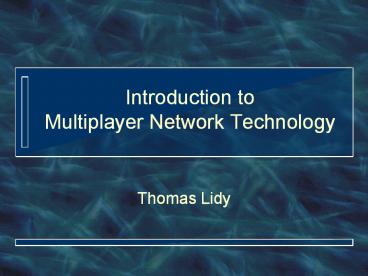Introduction to Multiplayer Network Technology PowerPoint PPT Presentation
Title: Introduction to Multiplayer Network Technology
1
Introduction toMultiplayer Network Technology
- Thomas Lidy
2
Introduction
- Networking - used in ...
- e-commerce
- training education
- distributed engineering design
- entertainment
- multi player games
- ? networked virtual environments
3
Networked Virtual Environment
- software system
- multiple users interact in real-time
- shared sense of space and time
- realistic 3D graphics and sound
- a way to communicate
- interaction with the virtual environment
4
Networked Virtual Environment
- components
- graphics engines and displays
- communication and control devices
- processing systems
- data network
5
Origins of virtual environments
- origins in military (and industry)
- academic research in networked virtual
environments - virtual worlds on PC class systems- 3D games
6
Origins in military
- SIMNET
- started 1983
- developed for DARPA
- DIS (protocol)
- defined after 1989
- standardized packets (PDUs)
- distributed heterogeneous
7
Origins in industry
- SGI - Flight (1984)
- SGI - Dogfight (1985)
Academic origins
Flight
- NPSNET (1986)
- PARADISE (1993)
- BrickNet (1991)
8
Origins on PC class machines
- Doom (1993)
- Macintosh
- Marathon (1994)
- Bolo (tank game)
Doom
- ... and many others
Bolo
9
Network Technology
- Issues for networking
- Latency
- time required from one host to another
- Bandwidth
- data rate how many bits per second
- Reliability
- how much data is lost
10
Sockets and Ports
- allow multiple applications to use the network
Applications ftp www netVEs games
port s protocols IP layer
IP (Internet Protocol)
11
Internet Protocol (IP)
- low-level protocol
- basic services
- splits reassembles packets
- TTL field (time to live)
- other protocols lie on top of IP
12
Transmission Control Protocol (TCP)
- layered on top of IP (? TCP/IP)
- simple point-to-point connection
- automatic acknowledgments
- error checking
- correct packet order
- ?reliability
13
User Datagram Protocol (UDP)
- also layered on top of IP
- connectionless
- packet-by-packet basis
- best-efforts delivery (not reliable)
- less processing time ? faster
- deal with packet loss and ordering!
14
IP Broadcasting
- instead of sending multiple copiesof a packet to
all destinations - single transmission to all hosts in the network
- broadcasting to address 255.255.255.255
- disadvantages
- expensive for hosts that are not interested
- delivery only on LAN - not Internet-wide!
15
IP Multicasting
- receiver-controlled distribution
- interested hosts subscribe to a list
- packets are sent down distribution paths
- no burdens for hosts not interested
- less overhead than broadcasting
- appropriate for Internet use
16
Multicast routing
New York
Moscow
Washington
London
Tokyo
Denver
Prague
Munich
Vienna
Graz
17
IP Multicasting
- addressing
- pseudo IP (class D address)range 224.0.0.0 -
239.255.255.255 - can be used temporarily or reserved by IANA
- problems
- routers must be multicast-capable
- not yet available troughout the Internet
- ?multicast routers communicate directly with each
other through the MBONE
18
Overview (1)
19
Overview (2)
20
Networking today - Conclusion
- networkingessential part of multi player
environments - designers must carefully selectprotocols and
network archtitecture - multicasting most efficient technique for
large-scale netVEs - games today use client/server, peer-to-peer
- multicasting probably becomes more globally
available with IPv6
21
The End
- Thomas Lidy

